3M Scott Technologies 200427 Emergency Alarm Transmitter User Manual 595103 01
Scott Safety-Division of Scott Technologies, Inc. Emergency Alarm Transmitter 595103 01
Manual
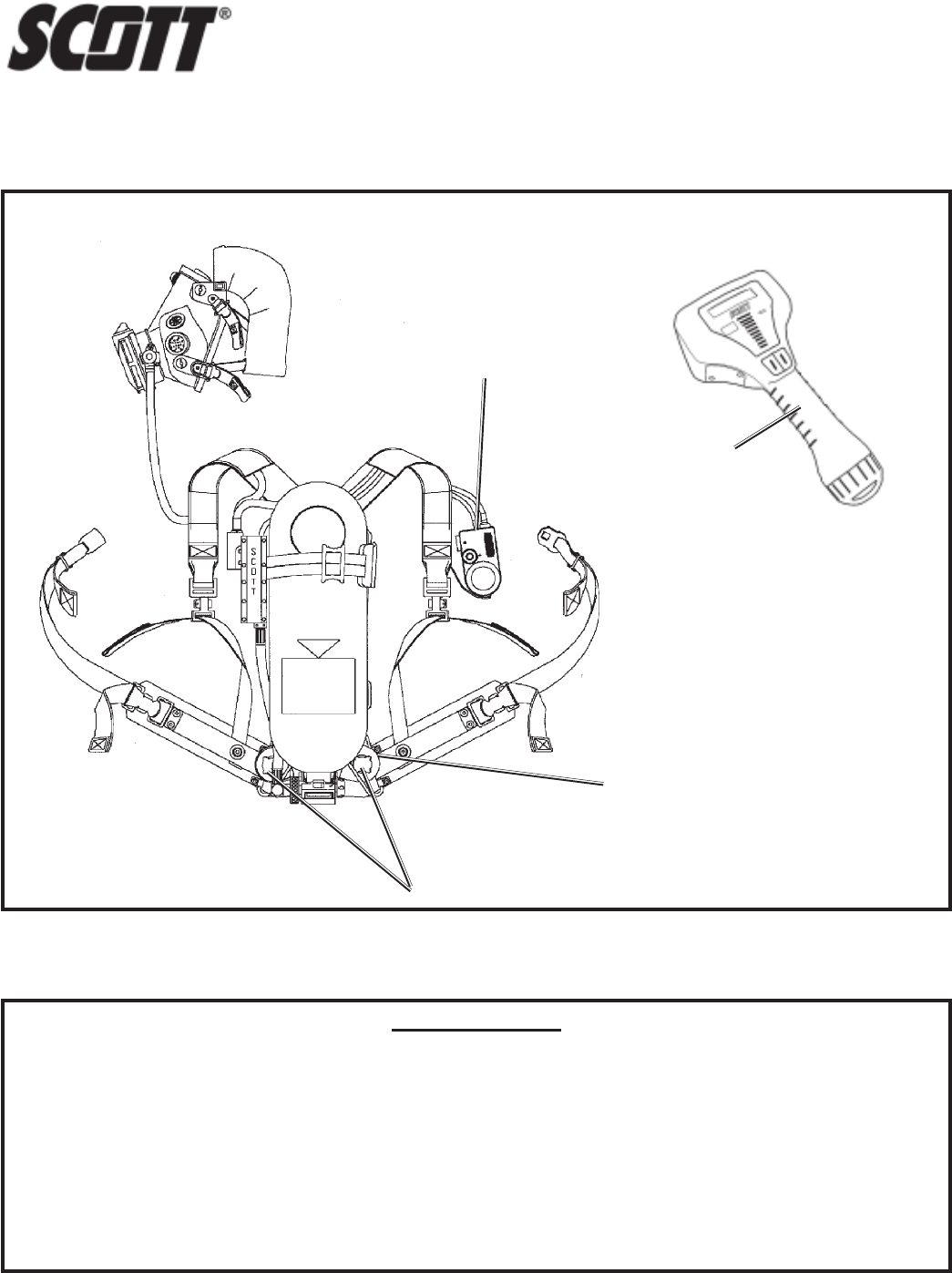
1
DRAFT COPY
DRAFT COPY
FIGURE 1
AIR-PAK SCBA WITH PAK-ALERT DISTRESS ALARM ASSEMBLY
AND INTEGRATED TRANSMITTER
CONTROL CONSOLE
ASSEMBLY
SENSOR MODULE ASSEMBLY
WITH INTEGRAL TRANSMITTER
WARNING
THE SCOTT PAK-ALERT DISTRESS ALARM IS INTENDED FOR USE WITH SCOTT SELF-CONTAINED
BREATHING APPARATUS (SCBA) WHICH MAY SUPPORT HUMAN LIFE IN HAZARDOUS ATMOSPHERES.
FAILURE TO CAREFULLY READ AND UNDERSTAND THE FOLLOWING INSTRUCTIONS MAY RESULT
IN SERIOUS INJURY OR DEATH TO THE SCBA USER.
USE OF A RESPIRATOR INTEGRATED WITH A PAK-ALERT DISTRESS ALARM WILL REQUIRE MODI-
FICATION OF THE RESPIRATOR "REGULAR OPERATIONAL INSPECTION PROCEDURES" AND WILL
REQUIRE TRAINING OF THE RESPIRATOR USER IN THE USE OF PASS EQUIPPED RESPIRATORS.
THE FOLLOWING INSTRUCTIONS SUPPLEMENT BUT DO NOT REPLACE THE OPERATING AND
MAINTENANCE INSTRUCTIONS SUPPLIED WITH EACH RESPIRATOR.
Copyright © 2006, SCOTT, All Rights Reserved
OPERATION AND MAINTENANCE INSTRUCTIONS FOR
SCOTT PAK-ALERT
TM
DISTRESS ALARM
WITH SCOTT PAK-TRACKER LOCATOR SYSTEM
INTEGRATED WITH AIR-PAK
®
2.2/3.0/4.5/Fifty
SELF-CONTAINED BREATHING APPARATUS (SCBA)
HAND HELD
RECEIVER
RED COVERS
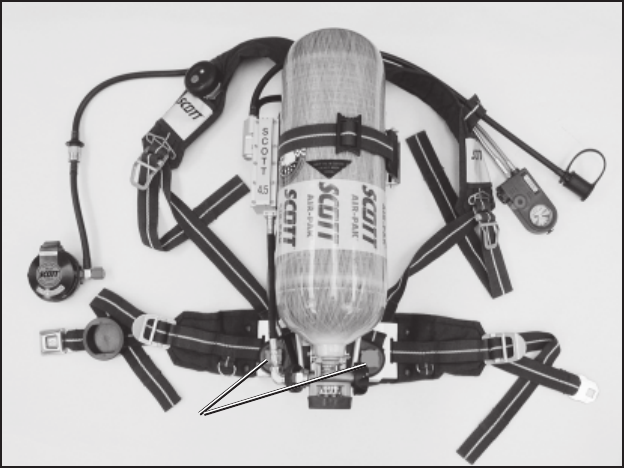
2
DRAFT COPY
DRAFT COPY
WARNING
NO PERSONAL ALERT SAFETY SYSTEM, RES-
PIRATOR OR COMBINATION OF PERSONAL
ALERT SAFETY SYSTEM AND RESPIRATOR, BY
THEMSELVES, CAN PROVIDE COMPLETE PRO-
TECTION IN FIRE SITUATIONS. HOWEVER,
USING AN ALARM AND A RESPIRATOR IN AC-
CORDANCE WITH THE REQUIREMENTS OF AN
ORGANIZED RESPIRATORY PROTECTION
PROGRAM IS ONE OF THE MANY SAFETY PRE-
CAUTIONS WHICH SHOULD BE TAKEN TO
AVOID PERSONAL INJURY OR DEATH.
WARNING
USERS OF RESPIRATORS EQUIPPED WITH
THE PAK-ALERT DISTRESS ALARM MUST BE
AWARE OF THE PROPER OPERATION OF THE
DISTRESS ALARM. IF THE GREEN LIGHT IS
NOT FLASHING NORMALLY, OR IF THE UNIT
EXHIBITS ANY OTHER SIGNS OF A MALFUNC-
TION WITHOUT THE USER TAKING PROPER
CORRECTIVE ACTION, IT MAY LEAD TO CIR-
CUMSTANCES THAT RESULT IN SERIOUS
INJURY OR DEATH.
WARNING
DO NOT OPERATE THIS EQUIPMENT WHILE
UNDER THE INFLUENCE OF DRUGS, ALCO-
HOL, OR ANY MEDICATIONS OR SUBSTANCES
WHICH MAY AFFECT VISION, DEXTERITY, OR
JUDGMENT. USERS OF THIS EQUIPMENT
MUST BE IN GOOD PHYSICAL AND MENTAL
HEALTH IN ORDER TO OPERATE SAFELY. DO
NOT USE THIS EQUIPMENT WHEN FATIGUE
PREVENTS SAFE OPERATION. STAY ALERT
WHEN OPERATING THIS EQUIPMENT. INAT-
TENTION OR CARELESSNESS WHILE
OPERATING THIS EQUIPMENT MAY RESULT IN
SERIOUS INJURY OR DEATH.
THE SCOTT PAK-ALERT DISTRESS ALARM
DESCRIPTION
The PAK-ALERT SE + distress alarm is a PERSONAL ALERT SAFETY SYS-
TEM (PASS) intended to assist in locating a respirator user who is
incapacitated or in need of assistance. The SCOTT PAK-ALERT distress
alarm is an optional accessory intended only for the SCOTT AIR-PAK® 2.2/
3.0/4.5/Fifty Self-Contained Breathing Apparatus (SCBA).
The SCOTT PAK-ALERT distress alarm consists of a sensor module
mounted to the bottom of the respirator backframe, a pressure switch
mounted between the cylinder and gauge line, and a control console
mounted on the wearer’s right shoulder strap at the pressure gauge loca-
tion. The SCOTT PAK-ALERT distress alarm reaches full alarm in a total of
thirty (30) seconds.
In addition to the standard PASS functionality, the PAK-ALERT SE + is also
equipped with a SCOTT PAK-TRACKER locator device which is activated
with the PASS alarm. The locator has a transmitter which emits a radio
signal that can be tracked using the SCOTT PAK-TRACKER Hand Held
Receiver unit. The SCOTT PAK-ALERT SE + equipped with the locator
transmitter can be identified by the two RED covers on the Sensor Module.
See FIGURE 2.
The SCOTT PAK-TRACKER Locator System is a two part electronic system
consisting of a PAK-TRACKER Transmitter, which is integrated into the PAK-
ALERT SE + distress alarm, and a PAK-TRACKER Hand Held Receiver,
which is a directional receiver or “sniffer” used to locate the signal coming
from the PAK-TRACKER Transmitter. This line of electronic accessories is
for use by fire fighters, first responders, domestic preparedness and law
enforcement officers, as well as haz-mat and industrial users.
The PAK-TRACKER Transmitter works in conjunction with the PAK-ALERT
SE + distress alarm. A short time after activation of the full alarm, the unit
begins transmitting a signal with a unique ID number that can be received by
the PAK-TRACKER Hand Held Receiver.
The PAK-TRACKER Hand Held Receiver is then used as a directional sen-
sor to lead the rescue crew to the downed user. By pointing the
PAK-TRACKER Hand Held Receiver in the direction of the strongest signal,
the rescue crew can follow the signal to the downed user.
FIGURE 2
RED COVERS ON SENSOR MODULE
RED COVERS ON
SENSOR MODULE
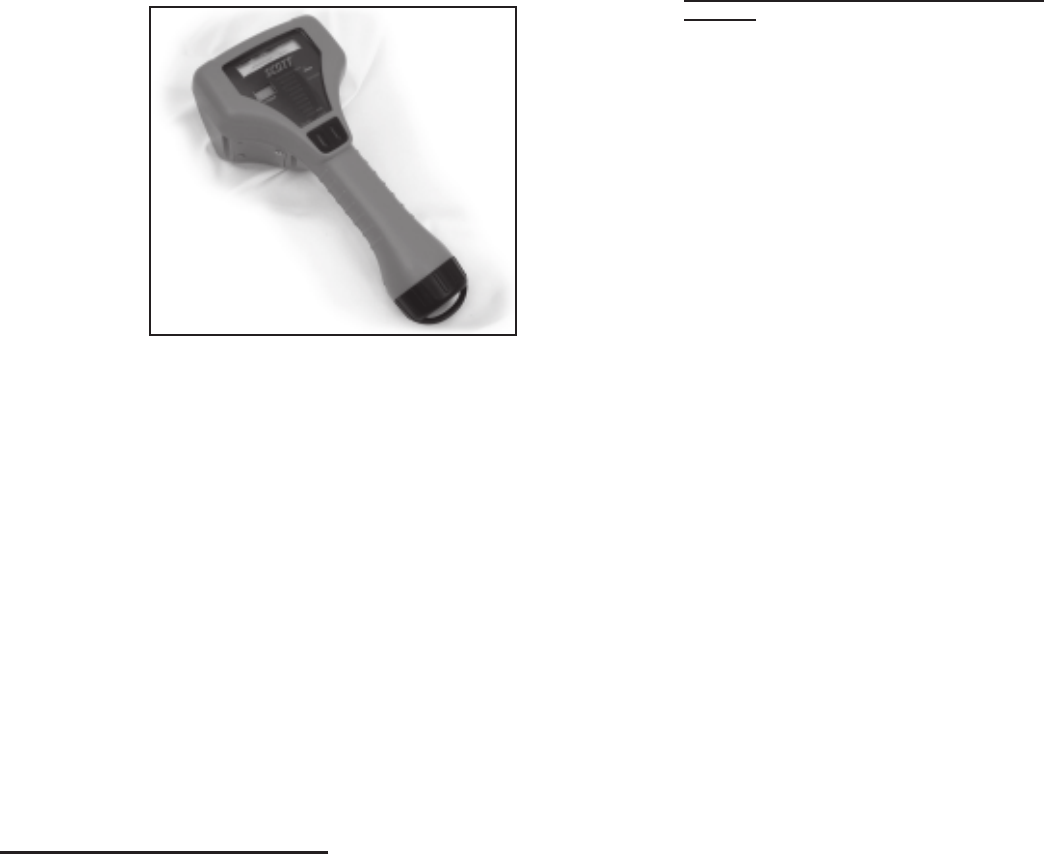
3
DRAFT COPY
DRAFT COPY
Training and practice in realistic emergency simulations is required before
use of this equipment. The users must become thoroughly familiar with the
operation and the limitations of the system before entering a potentially haz-
ardous or life threatening situation. The SYSTEM USE instructions, SCOTT
part number 595102-01, comprise instructions for both the PAK-TRACKER
Hand Held Receiver and the PAK-TRACKER Transmitter. Those instructions
are to be used as the basis of training for use of the whole system and in-
clude an overview of the system operation and limitations of the system, as
well as any user level maintenance.
QUESTIONS OR CONCERNS
If you have any questions or concerns regarding use of this equipment, con-
tact your authorized SCOTT dealer or distributor, or contact SCOTT at
1-800-247-7257 (or 704-291-8300 outside the continental United States) or
visit our web site at www.scotthealthsafety.com.
1 Kevlar is a registered trademark of E. I. Du Pont de Nemours, Inc.
The SCOTT PAK-ALERT distress alarm is approved by the National Insti-
tute of Occupational Safety and Health (NIOSH) on all models of SCOTT
AIR-PAK 2.2/3.0/4.5/Fifty SCBA except as specified in the limitations of
use on the SCBA approval label and in the SCBA Operating and Mainte-
nance Instructions.
NIOSH certified SCBA’s are limited to a maximum weight of 35 lbs. When
the PAK-ALERT distress alarm is used with a one hour duration SCOTT
SCBA, either the Kevlar1 wrapped (SCOTT P/N 804222-01) or Carbon
wrapped (P/N 804723-XX) cylinder and valve assembly must be used to
keep the total weight under 35 lbs. limit. Using the PAK-ALERT distress
alarm with fiberglass wrapped one hour cylinder and valve assemblies,
(SCOTT P/N 804107-01 or P/N 802827-01), will exceed 35 lbs.
Installation of a SCOTT PAK-ALERT distress alarm requires some disas-
sembly of the respirator. Installation instructions are contained in a separate
SCOTT Instruction Manual, P/N 89489-01, available from your SCOTT dis-
tributor or from SCOTT HEALTH AND SAFETY.
FIGURE 3
PAK-TRACKER HAND HELD RECEIVER
WARNING
READ AND UNDERSTAND THIS ENTIRE
MANUAL. TRAINING IS REQUIRED BEFORE
USE OF THIS EQUIPMENT IN A HAZARDOUS
SITUATION. THE TRAINING MUST INCLUDE EX-
TENSIVE PRACTICE WITH THE SYSTEM IN A
VARIETY OF ENVIRONMENTS AND A COM-
PLETE UNDERSTANDING OF HOW TO
INTERPRET LOCATING INFORMATION. BE-
CAUSE DIFFERENT BRANDS AND MODELS OF
PERSONNEL LOCATORS MAY OPERATE DIF-
FERENTLY, ALWAYS UPDATE TRAINING WITH
EACH NEW PIECE OF EQUIPMENT. USE OF A
LOCATOR SYSTEM WITHOUT PROPER TRAIN-
ING MAY PLACE THE USER AT HIGHER RISK
IN DANGEROUS SITUATIONS WHICH COULD
RESULT IN SERIOUS INJURY OR DEATH.
4
DRAFT COPY
DRAFT COPY
WARNING
IF THE PAK-ALERT DISTRESS ALARM IS USED
IN AN AREA OF EXPLOSIVE OR FLAMMABLE
HAZARDS, FAILURE TO REGULARLY INSPECT
AS INSTRUCTED, FAILURE TO CORRECT DAM-
AGE BEFORE USE OR THE INSTALLATION OF
INCORRECT BATTERIES MAY LEAD TO A FIRE
OR EXPLOSION WHICH MAY RESULT IN PER-
SONAL INJURY OR DEATH.
INTRINSICALLY SAFE LISTING
The PAK-ALERT distress alarm with Integrated Locator transmitter, Model
Number 805796-SERIES, when installed on a SCOTT respirator, is listed as
intrinsically safe per ANSI/UL Std. UL-913 in Class I, Division 1 Groups A, B,
C and D hazardous locations by SGS U. S. TESTING COMPANY, Inc. only
when powered by the batteries listed in this instruction or indicated on the
label on the sensor module.
To maintain Intrinsic Safety Listing, inspect the respirator with PAK-ALERT
distress alarm regularly per the Regular Operational Inspection procedures
in this instruction. Substitution of Components May Impair Intrinsic Safety.
To reduce the risk of ignition of a flammable atmosphere, batteries must
only be changed in an area known to be nonflammable. To reduce the risk
of explosion, do not mix old batteries with unused batteries, or mix batter-
ies from different manufacturers.
SAFETY LISTINGS
WARNING
THE HAND HELD RECEIVER IS A BATTERY OP-
ERATED ELECTRICAL DEVICE THAT HAS NOT
BEEN EVALUATED FOR INTRINSIC SAFETY AS
AN IGNITION SOURCE. THIS DEVICE IS NOT TO
BE USED IN A POTENTIALLY EXPLOSIVE AT-
MOSPHERE. ALWAYS CHECK FOR THE
PRESENCE OF FLAMMABLE OR EXPLOSIVE
GASES BEFORE ENTERING AN UNKNOWN AT-
MOSPHERE WITH THE HAND HELD RECEIVER.
USE OF THE HAND HELD RECEIVER IN A FLAM-
MABLE OR EXPLOSIVE ATMOSPHERE MAY
RESULT IN IGNITION OF THE ATMOSPHERE
RESULTING IN SERIOUS INJURY OR DEATH.
NOTE
DETAILS OF THE SAFETY LISTINGS AND APPROVALS FOR THE HAND
HELD RECEIVER ARE INCLUDED IN THE USER INSTRUCTIONS PRO-
VIDED WITH THE HAND HELD RECEIVER.
5
DRAFT COPY
DRAFT COPY
WARNING
RADIO FREQUENCY INTERFERENCE (RFI) MAY
CAUSE A MALFUNCTION OF THE PAK-ALERT
DISTRESS ALARM. USERS OF RESPIRATORS
EQUIPPED WITH THE PAK-ALERT DISTRESS
ALARM MUST BE AWARE OF THE PROPER OP-
ERATION OF THE DISTRESS ALARM. FAILURE
TO RECOGNIZE A MALFUNCTION OF THE PAK-
ALERT DISTRESS ALARM AND TAKE PROPER
CORRECTIVE ACTION MAY RESULT IN SERI-
OUS INJURY OR DEATH.
RADIO FREQUENCY INTERFERENCE (RFI)
When any electronic device is adversely affected by radio waves, Radio
Frequency Interference (RFI) is said to have occurred. All electronic de-
vices like the PAK-ALERT distress alarm may be subject to the effects of
RFI, most of which are temporary in nature. Users of the SCOTT AIR-PAK
SCBA with the integrated PAK-ALERT distress alarm must be familiar with
the normal operation of the distress alarm and must also be familiar with
how to identify and avoid the effects of RFI (see DETECTING AND AVOID-
ING RADIO FREQUENCY INTERFERENCE on page 6). If RFI occurs to
the PAK-ALERT distress alarm, it may be caused by transmissions from
base stations or high-powered vehicle mounted radios or transmissions
from hand-held or personal radios where the radio antenna is touching or
very close to (less than 6 inches from) components of the PAK-ALERT
distress alarm.
FCC COMPLIANCE
FCC Compliance Statement (Part 15.19)
This device complies with Part 15 of the FCC Rules. Operation is subject to
the following two conditions:
1. This device may not cause harmful interference, and
2. This device must accept any interference received,
including interference that may cause undesired operation.
FCC Warning (Part 15.21)
Changes or modifications not expressly approved by the party responsible
for compliance could void the user’s authority to operate the equipment.
This portable transmitter with its antenna complies with FCC’s RF exposure
limits for general population / uncontrolled exposure.
The Locator Personal Transmitter has been assigned FCC ID # T5E-200427.
INDUSTRY CANADA COMPLIANCE
Industry Canada Statement
The term “IC” before the certification / registration number only signifies that
the Industry Canada technical specifications were met.
Section 14 of RSS-210
The installer of this radio equipment must ensure that the antenna is located
or pointed such that it does not emit RF field in excess of Health Canada
limits for the general population. Consult Safety Code 6, obtainable from
Health Canada’s web site: www.hc-sc.gc.ca/rpb.
SAFETY LISTINGS Continued...
CLASS B DIGITAL DEVICE
Note: This equipment has been tested and found to comply with the limits for
a Class B digital device, pursuant to Part 15 of the FCC Rules. These limits
are designed to provide reasonable protection against harmful interference
in a residential installation. This equipment generates, uses and can radiate
radio frequency energy and, if not installed and used in accordance with the
instructions, may cause harmful interference to radio communications. How-
ever, there is no guarantee that interference will not occur in a particular
installation. If this equipment does cause harmful interference to radio or
television reception, which can be determined by turning the equipment off
and on, the user is encouraged to try to correct the interference by one or
more of the following measures:
– Reorient or relocate the receiving antenna
– Increase the separation between the equipment and receiver.
– Connect the equipment into an outlet on a circuit different from that to
which the receiver is connected.
– Consult the dealer or an experienced radio/TV technician for help.
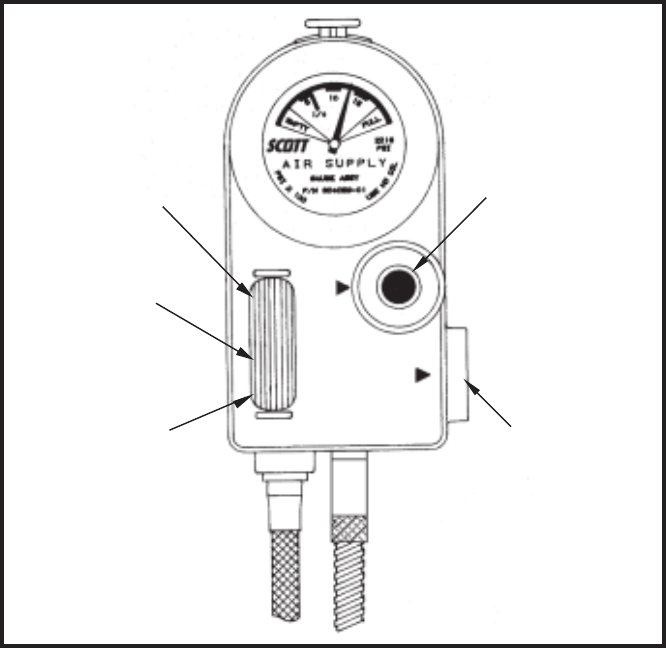
6
DRAFT COPY
DRAFT COPY
WARNING
THE INFORMATION BELOW IS MEANT TO
SUPPLEMENT, NOT REPLACE, THE TRAINING,
SUPERVISION, MAINTENANCE, AND OTHER
ELEMENTS OF YOUR ORGANIZED RESPIRA-
TORY PROTECTION PROGRAM. SEE WARNING
ON FIRST PAGE OF THIS DOCUMENT. FAILURE
TO COMPLY WITH THESE INSTRUCTIONS MAY
RESULT IN SERIOUS INJURY OR DEATH.
WARNING
USERS OF RESPIRATORS EQUIPPED WITH
THE PAK-ALERT DISTRESS ALARM MUST BE
AWARE OF THE PROPER OPERATION OF THE
DISTRESS ALARM. FAILURE TO RECOGNIZE A
MALFUNCTION OF THE PAK-ALERT DISTRESS
ALARM AND TAKE PROPER CORRECTIVE AC-
TION MAY RESULT IN SERIOUS INJURY OR
DEATH.
OPERATION OF THE SCOTT
PAK-ALERT DISTRESS ALARM
With proper batteries and a charged air cylinder installed, the PAK-ALERT
distress alarm device is automatically activated when the respirator is pres-
surized by opening the cylinder valve of the respirator.
To indicate activation, the sensor module will sound 3 quick audible chirps
and the green light located on the control console will flash approximately
once a second. See FIGURE 4. The PAK-ALERT distress alarm is now in the
automatic mode.
In the automatic mode, the SCOTT PAK-ALERT distress alarm constantly
monitors motion of the respirator backframe. The sensor module is located
on the respirator backframe beneath the air cylinder and contains the motion
sensor and the audible alarm. If the sensor module does not sense motion of
the respirator for twenty (20) seconds, the PAK-ALERT distress alarm will
signal a pre-alarm condition. If there is still no motion of the respirator for the
next twelve (12) seconds the full alarm will sound.
The SCOTT PAK-ALERT distress alarm will remain activated in the auto-
matic mode until turned OFF according to these instructions.
FIGURE 4
THE CONTROL CONSOLE
RESET
BUTTON
(YELLOW
INDICATOR)
MANUAL
ALARM
BUTTON
(RED INDICATOR)
RED SIGNAL
LIGHT
CONSOLE
LENS
GREEN SIGNAL
LIGHT
MANUAL
ALARM
RESET
PUSH
TWICE

7
DRAFT COPY
DRAFT COPY
PRE-ALARM
If the respirator remains motionless for more than twenty (20) seconds, the
PAK-ALERT distress alarm will automatically sound a pre-alarm
When the pre-alarm occurs, the green flashing light on the control console is
replaced by a bright red light which flashes approximately once a second
and is accompanied by an ascending/descending audible tone which in-
creases in volume during the pre-alarm cycle.
If the respirator user is not incapacitated or not in need of assistance, move
the respirator to reset the pre-alarm. When reset, the flashing red light will be
replaced by the flashing green and the ascending/descending tone will stop.
Remember that the motion sensor is in the sensor module on the respirator
backframe beneath the air cylinder. Actual movement of the respirator
backframe is required to reset the pre-alarm. Shaking the control console
will not reset the PAK-ALERT distress alarm .
To manually reset the pre-alarm, press and hold the reset button on the
side of the control console until three (3) quick audible chirps are heard
and the red flashing light on the control console is replaced by the green
flashing light.
FULL ALARM
If the respirator remains motionless through the twelve (12) second pre-alarm
cycle, the PAK-ALERT distress alarm will go into full alarm. This may indi-
cate that the user is incapacitated or in need of assistance and can not move.
Full alarm is indicated by a loud, almost continuous 3 tone chirp from the
sensor module accompanied by the flashing red signal light on the control
console. Ten (10) seconds after the full alarm condition starts, the Locator
Transmitter will begin to transmit the unique ID number for the unit. To reset
the full alarm condition, press the reset button twice. See FIGURE 4.
After the full alarm has been silenced by pressing the reset button twice, the
PAK-ALERT distress alarm will remain activated in the automatic mode with
the green light flashing once per second. As long as the respirator is pressur-
ized, there must be movement of the respirator at least every twenty (20)
seconds or the distress alarm will again go into pre-alarm followed by full
alarm as described above.
MANUAL ALARM
If the respirator user requires immediate assistance, pressing the manual alarm
button located on the front of the control console will immediately sound the full
alarm. See FIGURE 4. The manual alarm may be activated at any time, even
when the respirator is not pressurized.
If the manual alarm is activated when the respirator is not pressurized, press
the reset button twice to silence the alarm. The PAK-ALERT distress alarm
will remain on in automatic mode. To turn the unit off, press the reset twice
again while the unit is not in alarm mode.
Remember, the loud audible alarm and flashing red light can be turned on at
any time by pressing the manual alarm button on the control console.
WARNING
USERS OF RESPIRATORS EQUIPPED WITH
THE PAK-ALERT DISTRESS ALARM MUST BE
AWARE OF THE PROPER OPERATION OF THE
DISTRESS ALARM. FAILURE TO RECOGNIZE A
MALFUNCTION OF THE PAK-ALERT DISTRESS
ALARM AND TAKE PROPER CORRECTIVE AC-
TION MAY RESULT IN SERIOUS INJURY OR
DEATH.
OPERATION OF THE PAK-ALERT DISTRESS ALARM
CONTINUED ON NEXT PAGE...

8
DRAFT COPY
DRAFT COPY
WARNING
FAILURE TO REPLACE THE BATTERIES AND/
OR CONTINUING WITH MULTIPLE USES OF
THE RESPIRATOR AFTER THE LOW BATTERY
CONDITION HAS BEEN INDICATED BY THE
PAK-ALERT DISTRESS ALARM MAY RESULT IN
FAILURE OF THE PAK-ALERT DISTRESS
ALARM DURING USE AND POSSIBLE INJURY
OR DEATH OF THE USER.
LOW BATTERY
In a low battery condition, the PAK-ALERT distress alarm will produce a single
audible chirp from the sensor module once every two (2) seconds and the
green light on the control module will not flash.
While in low battery condition, the PAK-ALERT distress alarm will continue to
operate for a period of time greater then the longest duration cylinder avail-
able for the respirator. However, the batteries must be replaced before the
respirator is used again. See THE BATTERY REPLACEMENT section of
these instructions.
If batteries are completely discharged or have not been installed, there will
be no light or sound and the unit will not operate.
BATTERY TEST
To test the batteries, verify that the PAK-ALERT distress alarm is in the off
condition (cylinder valve closed with no flashing green LED on the control con-
sole). Press and hold the reset button on the console.
A green light on the console will illuminate to indicate sufficient battery power
remaining. If a red light appears, the batteries must be replaced before the
respirator is used again.
TO TURN OFF THE PAK-ALERT DISTRESS ALARM
When use of the respirator with the PAK-ALERT distress alarm is no longer
required, close the cylinder valve on the respirator and vent the residual air
from the respirator system by opening the regulator purge valve. After all the
air flow stops, close the regulator purge valve and press the reset button twice
to turn off the PAK-ALERT distress alarm. The green flashing light will go out
and a fifteen (15) second beep sequence will sound from the sensor module.
When the unit sounds a quick two tone chirp, the PAK-ALERT distress alarm
will be inactive.
If the respirator cylinder valve is open and/or pressure remains in the respi-
rator, the PAK-ALERT distress alarm can not be turned off. Pressing the
reset button when the respirator is pressurized will only reset an alarm con-
dition and return the PAK-ALERT distress alarm to automatic mode.
If the respirator cylinder is turned off and depressurized without pressing the
reset button twice, the PAK-ALERT distress alarm will continue to monitor
motion in automatic mode. This means that the PAK-ALERT distress alarm
may be used to monitor motion after the respirator is turned off and depres-
surized. Resetting the full alarm after the respirator has been depressurized
will not turn off the PAK-ALERT distress alarm. Press the reset switch twice
with no alarm condition to turn off the PAK-ALERT distress alarm (the fifteen
(15) second beep sequence and two tone chirp will be heard).
OPERATION OF THE PAK-ALERT DISTRESS ALARM
CONTINUED...
9
DRAFT COPY
DRAFT COPY
PRINCIPLES OF OPERATION
OF THE PAK-TRACKER LOCATOR SYSTEM
When a PAK-TRACKER Transmitter is activated, it sends out a radio signal
that is received by the PAK-TRACKER Hand Held Receiver. Understanding
how the radio signal from a Transmitter behaves and how the Hand Held
Receiver receives and displays the strength of that signal are critical to un-
derstanding the operation of the SCOTT PAK-TRACKER Locator System.
When the PAK-TRACKER Transmitter is activated, the radio signal will ema-
nate equally in all directions. The PAK-TRACKER Hand Held Receiver
indicates the relative strength of the radio signal on the display in numbers
from 10 to 99 where 10 is the weakest signal and 99 is the strongest signal.
The relative strength of the radio signal detected by the PAK-TRACKER Hand
Held Receiver will vary depending on:
1. The distance from the Transmitter to the Hand Held Receiver,
2. What path the radio signal has taken to get to the Hand Held Receiver.
The further the signal has traveled as well as how often it has been reflected will
determine the relative strength of the signal when it reaches the Hand Held
Receiver. The PAK-TRACKER Hand Held Receiver is a directional receiver in
that it will display a higher relative signal strength when it is pointed at the specific
area where the signal is coming from. Since the signal is coming to the PAK-
TRACKER Hand Held Receiver from all directions in varying strengths, the
receiver is very sensitive in responding to small differences between a stronger
signal that is coming most directly from the transmitter and a weaker signal that
has reflected several times before reaching the receiver. The user of the Hand
Held Receiver must interpret the readings on the Hand Held Receiver display
and follow the strongest signal to reach the activated Transmitter.
The radio signal from the Transmitter will always follow a path of least resis-
tance to the receiver in the Hand Held Receiver. The radio signal will pass
through some materials and surfaces, while it will tend to reflect off other
materials. In general, the radio signal will pass through glass, wood, or light
building materials. The signal will reflect off large metal objects, concrete
walls or floors, brick, or concrete block construction.
The reflected signal will continue to move following the path of least resis-
tance through openings, down halls, and through doors and windows, or
through holes or gaps in walls and floors. The signal will follow the open
cavities of a building such as halls, stairways, or elevator shafts.
The PAK-TRACKER Hand Held Receiver and PAK-TRACKER Transmitter
are used to monitor personnel location both indoors and outdoors. Outdoors,
the range is approximately 1000 feet / 300 meters line of sight (LOS). If the
PAK-TRACKER Transmitter is located inside a building and a PAK-TRACKER
Hand Held Receiver is located outside the building, range is approximately
400 feet / 125 meters. If both the PAK-TRACKER Transmitter and PAK-
TRACKER Hand Held Receiver are totally indoors, the system has a range
of up to 250 feet / 75 meters.
WARNING
DO NOT USE THE HAND HELD RECEIVER IN
ATMOSPHERES WHERE FLAMMABLES ARE
OPENLY HANDLED OR MAY BE PRESENT CON-
TINUOUSLY. THE HAND HELD RECEIVER MAY
BE USED IN ATMOSPHERES WHERE FLAM-
MABLES ARE NORMALLY CONTAINED OR ARE
IN THE FORM OF DEPOSITS OR DUST. SEE THE
SAFETY STATEMENT ON PAGE 4. FAILURE TO
VERIFY THAT THE ATMOSPHERE IS NOT FLAM-
MABLE OR EXPLOSIVE BEFORE USING THE
HAND HELD RECEIVER MAY RESULT IN A FIRE
OR AN EXPLOSION WHICH COULD RESULT IN
SERIOUS INJURY OR DEATH.
RESTRICTED USE IN SOME LOCATIONS
The Hand Held Receiver may not be suitable for use in certain atmospheres
which could contain flammable or explosive gases in unknown levels. If any
of the following conditions may be present, do not use the Hand Held Re-
ceiver:
–Ignitable concentrations of flammable gases or vapors may be present
under normal conditions
–Ignitable concentrations of such gases or vapors may exist because of
repair or leakage
–Breakdown or faulty operation of equipment or processes might release
ignitable concentrations of flammable gases or vapors.
Always check for the presence of flammable or explosive gases before en-
tering an unknown atmosphere with the Hand Held Receiver.
WARNING
THE HAND HELD RECEIVER IS A BATTERY OP-
ERATED ELECTRICAL DEVICE THAT HAS NOT
BEEN EVALUATED FOR INTRINSIC SAFETY AS
AN IGNITION SOURCE. THIS DEVICE IS NOT TO
BE USED IN A POTENTIALLY EXPLOSIVE AT-
MOSPHERE. ALWAYS CHECK FOR THE
PRESENCE OF FLAMMABLE OR EXPLOSIVE
GASES BEFORE ENTERING AN UNKNOWN AT-
MOSPHERE WITH THE HAND HELD RECEIVER.
USE OF THE HAND HELD RECEIVER IN A FLAM-
MABLE OR EXPLOSIVE ATMOSPHERE MAY
RESULT IN IGNITION OF THE ATMOSPHERE
RESULTING IN SERIOUS INJURY OR DEATH.
10
DRAFT COPY
DRAFT COPY
WARNING
KEEP THE ANTENNAS OF HAND-HELD RADIOS
AT LEAST SIX (6) INCHES AWAY FROM THE
CONTROL CONSOLE AND THE SENSOR MOD-
ULE OF THE PAK-ALERT SE + DISTRESS
ALARM WHEN TRANSMITTING. CLOSE PROX-
IMITY OF RADIO EQUIPMENT TO THE
PAK-ALERT SE + DISTRESS ALARM DURING
RADIO TRANSMISSION MAY CAUSE THE UNIT
TO MALFUNCTION. FAILURE TO RECOGNIZE
A MALFUNCTION OF THE PAK-ALERT SE + DIS-
TRESS ALARM AND TAKE THE PROPER
CORRECTIVE ACTION MAY RESULT A NON-
WORKING DISTRESS ALARM WHICH WILL NOT
SOUND IF THE USER STOPS MOVING AND
LEAD TO SERIOUS INJURY OR DEATH.
WARNING
BE AWARE OF THE POTENTIAL EFFECT OF
RADIO TRANSMISSIONS FROM BASE STATION
OR TRUCK MOUNT RADIOS WHEN USING A
RESPIRATOR WITH THE PAK-ALERT SE + DIS-
TRESS ALARM. CLOSE PROXIMITY OF RADIO
EQUIPMENT TO THE PAK-ALERT SE + DIS-
TRESS ALARM DURING RADIO TRANSMISSION
MAY CAUSE THE UNIT TO MALFUNCTION. FAIL-
URE TO RECOGNIZE A MALFUNCTION OF THE
PAK-ALERT SE + DISTRESS ALARM AND TAKE
THE PROPER CORRECTIVE ACTION MAY RE-
SULT A NONWORKING DISTRESS ALARM
WHICH WILL NOT SOUND IF THE USER STOPS
MOVING AND LEAD TO SERIOUS INJURY OR
DEATH.
DETECTING AND AVOIDING
RADIO FREQUENCY INTERFERENCE
When any electronic device is adversely affected by radio waves, Radio Fre-
quency Interference (RFI) is said to have occurred. All electronic devices like
the PAK-ALERT SE + distress alarm may be subject to the effects of RFI.
Radio transmissions from the antennas of radios including those used by fire
fighters, police and other public safety related personnel may produce RFI in
the PAK-ALERT SE + distress alarm. RFI may occur while the radio is trans-
mitting if the respirator equipped with the PAK-ALERT SE + distress alarm is
in close proximity to a base station or high-powered vehicle mounted radio,
or if the antenna of a personal portable hand held radio is touching or within
six (6) inches of the Control Console or Sensor Module of the PAK-ALERT
SE + distress alarm. See FIGURE 5.
Be aware of the symptoms of RFI. A PAK-ALERT SE + distress alarm af-
fected by RFI may temporarily give false indications such as the sudden
sounding of the loud continuous three-tone chirp of the full alarm. In some
instances the lights on the control console may flash without sounding the
alarm. In rare circumstances, an alarm which was sounding may stop.
If the PAK-ALERT SE + exhibits any of the symptoms of RFI, identify the
source of the RFI and do the following:
–If the symptoms of RFI occur when standing near a base station trans-
mitting antenna or a truck mounted radio antenna, move away from the
antenna until the symptoms stop.
–If the symptoms of RFI occur while transmitting on a hand-held radio,
move the radio away from the PAK-ALERT SE +.
CHECK THE CONTROL CONSOLE AND BE CERTAIN THE GREEN LIGHT
IS FLASHING NORMALLY WHEN THE INTERFERENCE STOPS, REGARD-
LESS OF THE SOURCE.
In normal usage with the air cylinder open, the PAK-ALERT SE + distress
alarm will typically resume normal operation after experiencing RFI.
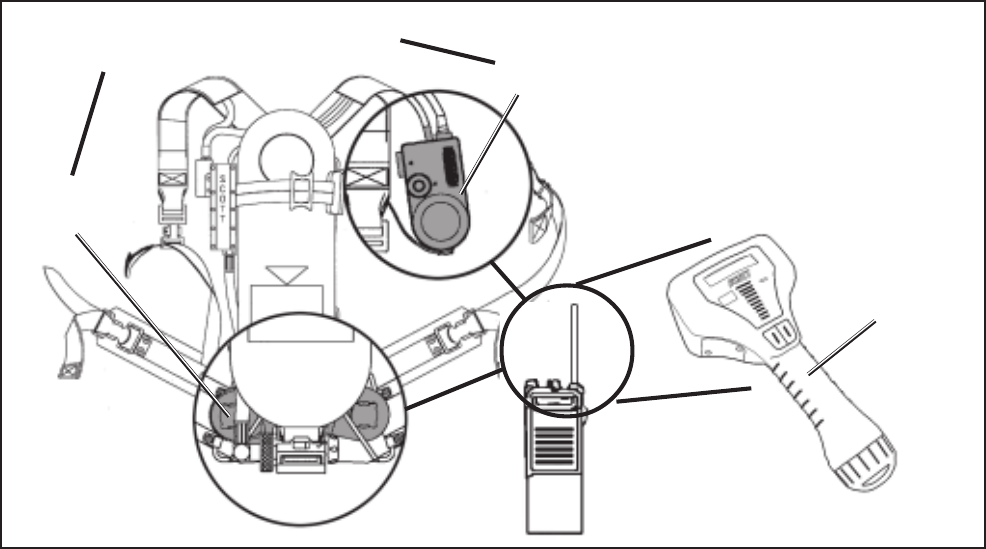
11
DRAFT COPY
DRAFT COPY
In some circumstances after experiencing RFI, it may be necessary to re-
move the unit from service. Remove and reinstall the batteries to reset the
unit (see BATTERY REPLACEMENT section of this instruction, page 10).
Then inspect and return the unit to service.
If the PAK-ALERT SE + distress alarm is affected by RFI when the respirator
air supply is turned off or the cylinder is empty, the distress alarm could be
turned off during use. If this occurs, depress the RED Manual Alarm Button
to activate the alarm.
IF THE SYMPTOMS OF RFI OCCUR, THE RESPIRATOR USER MUST
CHECK THE PAK-ALERT SE + DISTRESS ALARM TO VERIFY THAT IT IS
FUNCTIONING PROPERLY. IF THE GREEN LIGHT ON THE CONTROL
CONSOLE DOES NOT RESUME FLASHING IN THE NORMAL MANNER
AFTER EXPERIENCING THE SYMPTOMS OF RFI, OR IF THE UNIT CON-
TINUES TO MALFUNCTION IN ANY OTHER WAY, PROCEED TO A SAFE
AREA, REMOVE THE RESPIRATOR FROM SERVICE AND TAG FOR RE-
PAIR BY AUTHORIZED PERSONNEL.
Minimize or eliminate the effects of RFI by protecting the PAK-ALERT SE +
with the following steps:
– Maintain a safe distance from a base station transmitting antenna or a
truck mounted radio antenna.
– Keep the antennas of hand held radios at least six (6) inches away from the
CONTROL CONSOLE or the SENSOR MODULE. See FIGURE 5.
HAND
HELD
RE-
CEIVER
FIGURE 5
RFI WARNING AREAS
SENSOR
MODULE
CONTROL
CONSOLE
KEEP RADIO ANTENNAS AT LEAST
SIX (6) INCHES FROM THESE AREAS
12
DRAFT COPY
DRAFT COPY
WARNING
FOLLOW REGULAR OPERATIONAL INSPEC-
TION PROCEDURE EXACTLY. IF THE
PAK-ALERT DISTRESS ALARM DOES NOT AC-
TUATE, OR DOES NOT OPERATE AS
DESCRIBED OR IF ANY OTHER OPERATIONAL
MALFUNCTION IS NOTED, DO NOT USE THE
RESPIRATOR.
WARNING
IN SEVERAL OF THE INSPECTION PROCE-
DURES DESCRIBED A FULL ALARM WILL BE
OBSERVED. THE FULL ALARM CONDITION IN-
CLUDES AN AUDIBLE TONE THAT CAN EXCEED
95 DBA AT 3 METERS (9.9 FT.). IN ORDER TO
PREVENT POSSIBLE HEARING DAMAGE DUR-
ING TEST, THE ALARM SHOULD BE RESET
IMMEDIATELY ON VERIFICATION THAT IT IS
FUNCTIONING PROPERLY. HEARING PROTEC-
TION SHOULD BE WORN IF PROLONGED
EXPOSURE TO A FULL ALARM CONDITION IS
ANTICIPATED.
CAUTION
THE PERFORMANCE PROPERTIES OF THE
PAK-ALERT DISTRESS ALARM CANNOT BE
PROPERLY TESTED IN THE FIELD.
REGULAR OPERATIONAL INSPECTION
Inspect and test the SCOTT PAK-ALERT distress alarm along with the in-
spection and test of the SCOTT SCBA respirator before each use. Include
the following inspection procedures with the REGULAR OPERATIONAL IN-
SPECTION procedures defined in your respirator instructions. If any
malfunction of the respirator or the PAK-ALERT distress alarm is noted
during the inspection, remove the respirator from service and tag for repair
by authorized personnel.
To test the PAK-ALERT locator transmitter, you must have an operating
SCOTT PAK-TRACKER Hand Held Receiver.
NOTE
IF THIS INSPECTION IS DONE IN DIRECT SUNLIGHT IT MAY BE HELP-
FUL TO SHADE THE LENS ON THE CONTROL MODULE WITH YOUR
HAND TO BE SURE THE LIGHTS ARE FLASHING AS DESCRIBED.
1. While performing the visual inspection of the respirator, visually in-
spect all PAK-ALERT distress alarm enclosures, lenses, and wire
conduits for cracks, wear or other damage. If any damage is found,
remove the respirator from service and tag for repair by qualified per-
sonnel.
2. Turn on the SCOTT PAK-TRACKER Hand Held Receiver according to
the operating instructions provided with the unit. Position the Hand Held
Receiver near by.
3. With the cylinder valve closed, press the manual alarm button, located
on the front of the control console.
a) The manual alarm shall sound a loud almost continuous 3 tone chirp
accompanied by flashing of the red signal light on the control console.
b) The PAK-TRACKER Hand Held Receiver will sound an alarm and dis-
play the Identification Number of the PAK-ALERT which appears on
the label on the Sensor Module or the Control Console. Use the
SCROLL button on the Hand Held Receiver to highlight the active ID
number and press the ENTER button on the Hand Held Receiver to
select the displayed ID number. Point the unit directly at and in close
proximity to the respirator. The signal strength displayed will be at its
highest value.
4. Reset the manual alarm by pressing twice on the reset button located
on the side of the control console (fully depress reset button, release
and press again).
a) The unit will sound three chirps and the green light will flash.
b) The PAK-TRACKER Hand Held Receiver will reset to its non-alarm
state.
5. Turn the PAK-ALERT unit off by pressing the reset button twice again.
The unit will sound a two tone chirp and the green light will go out.
6. Open the cylinder valve to pressurize the respirator system. The PAK-
ALERT distress alarm shall sound 3 quick chirps and the light on the
control console shall begin flashing green about once a second. The 3
chirps will sound approximately the same time the VIBRALERT® in the
mask mounted regulator actuates briefly. Make sure the air flow is stopped
by pressing the air saver/donning switch.
7. To check the pre-alarm, leave respirator motionless for twenty (20) sec-
onds. The green flashing light shall be replaced by a red flashing light.
An ascending/descending tone will sound increasing in volume. Leave
the respirator motionless.
8. After the pre-alarm condition occurs, check the pre-alarm reset. Within
twelve (12) seconds of the pre-alarm, move the respirator to activate the
motion sensor. PAK-ALERT distress alarm shall reset to the automatic
mode. The red flashing light shall be replaced by a green flashing light
and the ascending/descending tone shall stop.
13
DRAFT COPY
DRAFT COPY
WARNING
IF THE LOW BATTERY INDICATION (ONE
STEADY CHIRP EVERY TWO (2) SECONDS
WITH NO FLASHING LIGHTS) OCCURS AT ANY
TIME DURING REGULAR OPERATIONAL IN-
SPECTION, DO NOT USE THE RESPIRATOR.
CHANGE THE BATTERIES IN THE SENSOR
MODULE IMMEDIATELY AND REPEAT THE
REGULAR OPERATIONAL TEST OR TAKE THE
RESPIRATOR OUT OF SERVICE UNTIL THE
BATTERIES ARE CHANGED AND THE REGULAR
OPERATIONAL TEST IS SUCCESSFULLY PER-
FORMED.
Continue with regular operational inspection of respirator as directed by
respirator instructions or your approved respiratory protection plan pro-
cedure. During the inspection the respirator must be moved or turned
every thirty (30) seconds or less to prevent the sounding of the full alarm.
After completion of all respirator checks and before turning off cyl-
inder valve:
1. Check the manual reset of the pre-alarm. Leave the respirator motion-
less until pre-alarm condition occurs. Within twelve (12) seconds press
and hold the reset button. Three (3) chirps shall sound, then release
button. The PAK-ALERT distress alarm shall reset to the automatic mode
and the flashing red light will be replaced by a flashing green light.
2. To check the full alarm, leave the respirator motionless until the pre-
alarm condition occurs. Do not reset.
a) The full alarm shall sound a loud almost continuous 3 tone chirp ac-
companied by flashing of the red signal light on the control console.
b) The PAK-TRACKER Hand Held Receiver will sound an alarm and dis-
play the Identification Number of the PAK-ALERT which appears on
the label on the Sensor Module or the Control Console. Use the
SCROLL button on the Hand Held Receiver to highlight the active ID
number and press the ENTER button on the Hand Held Receiver to
select the displayed ID number. Point the unit directly at and in close
proximity to the respirator. The signal strength displayed will be at its
highest value.
4. Reset the full alarm by pressing twice on the reset button located on the
side of the control console (fully depress reset button, release and
press again).
a) The loud alarm shall stop. The unit will sound three chirps and the
green light will flash. The unit shall reset to the automatic mode.
b) The PAK-TRACKER Hand Held Receiver will reset to its non-alarm
state.
5. Finish all respirator checks involving air flow and turn off the cylinder
valve. Use the purge valve to release all residual air pressure in the
system.
With the cylinder valve OFF:
1. Check the continuing operation of the PAK-ALERT distress alarm. The
PAK-ALERT distress alarm shall remain active with green light flash-
ing. Do not move respirator, pre-alarm shall occur with twenty (20)
seconds. Move respirator slightly, pre-alarm shall reset, green light shall
start flashing again.
2. To turn the PAK-ALERT distress alarm off, press the reset button twice
(press, release and press again). The green flashing light will go out and
a fifteen (15) second beep sequence will be heard from the sensor mod-
ule. When this sequence is complete, unit will sound a two tone chirp.
The PAK-ALERT distress alarm is now in the “OFF” condition.
NOTE
IF THE LOW BATTERY INDICATION (ONE STEADY CHIRP EVERY TWO
(2) SECONDS WITH NO FLASHING LIGHTS) OCCURS AT ANY TIME DUR-
ING REGULAR OPERATIONAL INSPECTION, DO NOT USE THE
RESPIRATOR. CHANGE THE BATTERIES IN THE SENSOR MODULE IM-
MEDIATELY AND REPEAT THE REGULAR OPERATIONAL TEST OR TAKE
THE RESPIRATOR OUT OF SERVICE UNTIL THE BATTERIES ARE
CHANGED AND THE REGULAR OPERATIONAL TEST IS SUCCESSFULLY
PERFORMED.
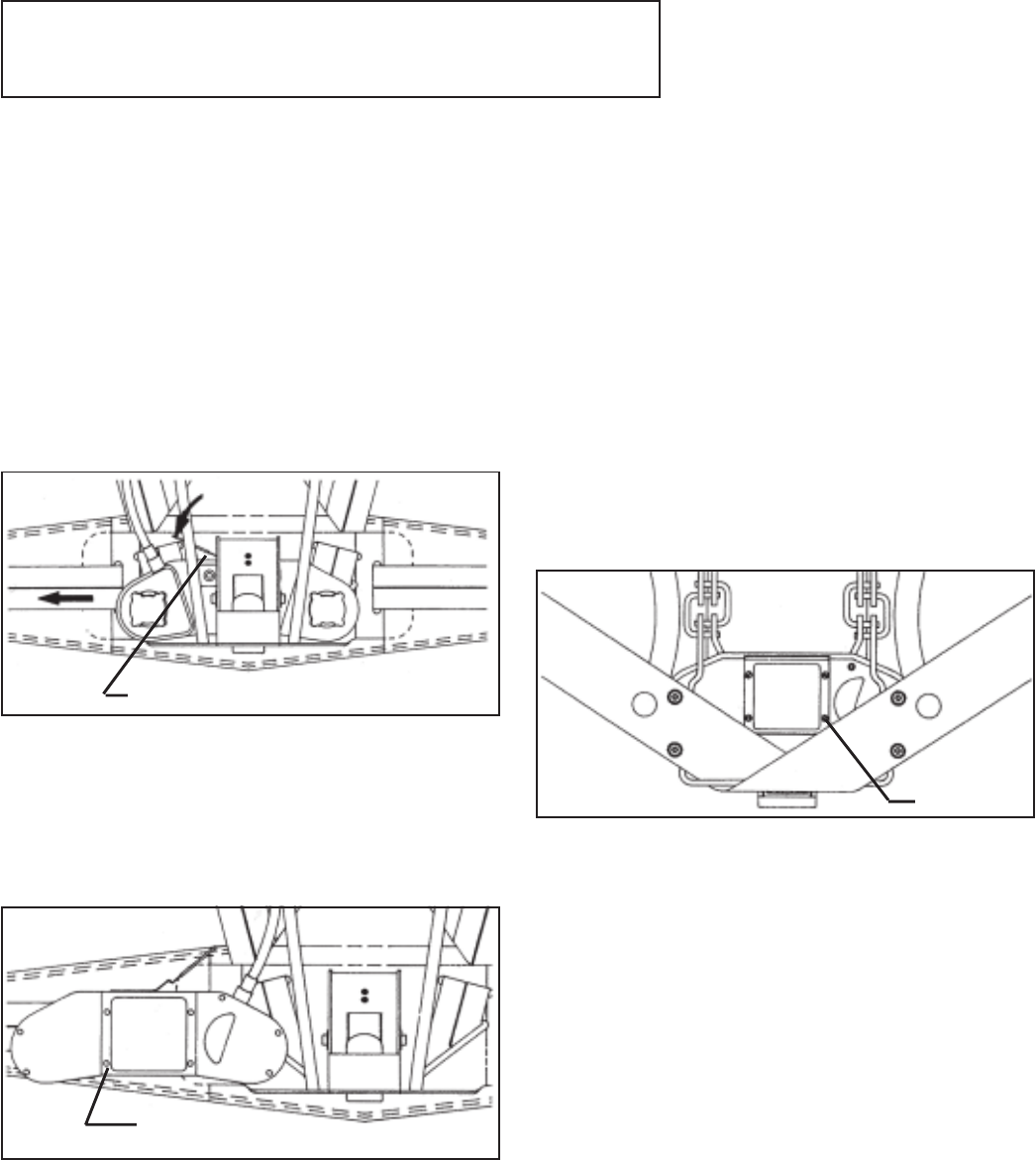
14
DRAFT COPY
DRAFT COPY
BATTERY REPLACEMENT
ALWAYS BE SURE THAT THE PAK-ALERT DISTRESS ALARM IS COM-
PLETELY INACTIVE BEFORE CHANGING BATTERIES. NEVER REMOVE
OR REPLACE BATTERIES WITH SYSTEM PRESSURIZED OR DAMAGE
MAY OCCUR TO ELECTRONIC COMPONENTS.
b. Depress the PAK-ALERT distress alarm retaining
spring and slide the Sensor Module from Backframe
as shown in FIGURE 6.
c. Turn the sensor module over to expose the battery
cover, shown in FIGURE 7 and replace batteries as
instructed in steps 5 through 10 of this section.
4. When replacing batteries on respirators equipped with
Wire Frame Backframe, P/N 804173-01:
a. Place the respirator with the cylinder side of the
backframe facing down exposing the battery cover
on the back of the sensor module, as shown in FIG-
URE 8.
b. Replace batteries as instructed in steps 5 through 9
of this section.
1. Place the respirator in a clean, non-hazardous area.
2. Remove the cylinder as follows:
a. Close the respirator cylinder valve.
b. Open the regulator purge valve to release any air trapped in the sys-
tem. Close the regulator purge valve.
c. Press the RESET button twice. The unit will beep as a fifteen (15)
second shut-down sequence occurs. When the sequence is complete,
the unit will sound a two tone chirp and the green light will go out.
d. Remove the high pressure coupling from the cylinder and remove the
cylinder from the backframe.
FIGURE 6
RETAINING SPRING
REMOVE
DEPRESS
FIGURE 7
BATTERY COVER
COVER SCREW
(4 PLACES)
FIGURE 8
BATTERY COVER
COVER
SCREW
(4 PLACES)
3. When replacing batteries on respirators equipped with
Aluminum Backframe, P/N 804415-01:
a. Place the respirator with the sensor module facing
upward as shown in FIGURE 6.
CAUTION
SYSTEM MUST NOT BE PRESSURIZED WHEN BATTERIES ARE INSTALLED. DAMAGE
TO THE ELECTRONIC COMPONENTS MAY RESULT IF BATTERIES ARE INSTALLED WITH
SYSTEM PRESSURIZED.
5. To remove battery cover, first loosen all four (4) cover
screws 1 or 2 turns each, then fully loosen all the
screws. Carefully remove cover and set aside.
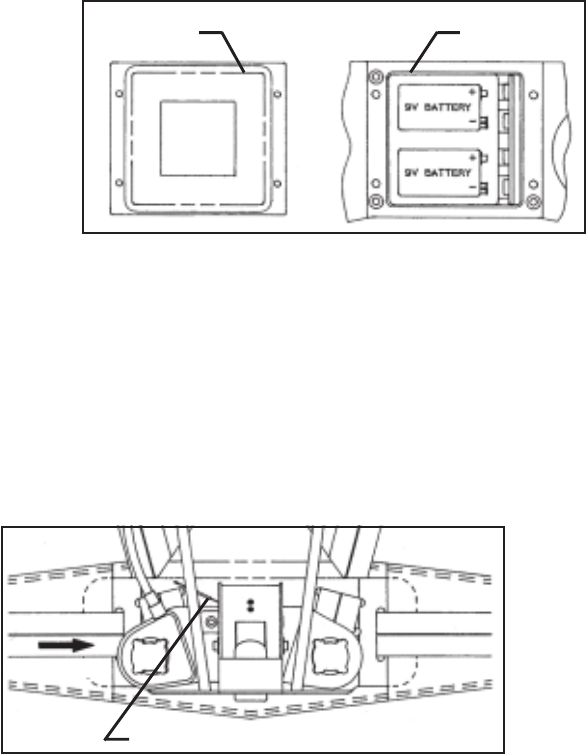
15
DRAFT COPY
DRAFT COPY
6. Remove both used batteries from the battery compartment by lifting the
edge of the batteries at the contact end, using a finger or the flat blade of
a screw driver. Be careful not to damage the battery contacts or the seal-
ing rib around the battery compartment.
7. Install two (2) fresh new batteries. Always replace both batteries at
the same time. Use only pairs of the following: Energizer2Alkaline No.
522 or EN22, Duracell3 Alkaline No. PC1604 or MN1604, or for increased
service life use Ultralife4 Lithium Battery No. U9VL. Be sure the batteries
are installed with the terminals positioned as indicated by the “+” and “-”
symbols molded in bottom of battery compartment.
8. The battery cover must be re-installed so that it is water tight. As shown
in FIGURE 9, clean the sealing rib around the battery compartment and
sealing face of the cover with a clean damp cloth to remove any dirt or
foreign matter which might prevent a proper seal. Check the cover gas-
ket for tears or cuts. If any damage is found, remove the respirator from
service and tag for repair by authorized personnel.
2 Energizer is a registered trademark of Eveready Battery Company, Inc., St Louis, MO.
3 Duracell is a registered trademark of The Gillette Company, Boston, MA.
4 Ultralife is a registered trademark of Ultralife Batteries, Inc., Newark, NY.
9. Re-install the battery cover and evenly tighten the four (4) cover screws
by moving around the cover in a clockwise direction, turning each screw
1 or 2 turns at a time until cover is fully seated and all four screws are
tight.
10. On respirators equipped with Aluminum Backframe,
P/N 804415-01, reinstall the sensor module by sliding
it back into the backframe until the retaining spring as
shown in FIGURE 10.
FIGURE 10
RETAINING SPRING
REPLACE
WARNING
THE PAK-ALERT DISTRESS ALARM IS IN-
TENDED TO ASSIST IN LOCATING A PERSON
WHO MAY BE IN A LIFE THREATENING SITUA-
TION. FAILURE TO FOLLOW THE
INSTRUCTIONS FOR OPENING, CHANGING THE
BATTERIES AND RE-CLOSING THE BATTERY
COMPARTMENT MAY RESULT IN DAMAGE
WHICH COULD CAUSE FAILURE OF THE PASS
DURING A LIFE THREATENING EMERGENCY
OR COULD CAUSE A FIRE OR EXPLOSION IN A
FLAMMABLE OR EXPLOSIVE ATMOSPHERE
POSSIBLY RESULTING IN INJURY OR DEATH.
CHECK YOUR WORK!
BEFORE ASSEMBLY OF BATTERY COVER,
CHECK TO SEE BOTH BATTERIES ARE FRESH,
NEW BATTERIES OF THE TYPE INDICATED
ABOVE AND THAT THEY HAVE BEEN IN-
STALLED PROPERLY.
FIGURE 9
BATTERY COMPARTMENT AND COVER SEAL
SEALING
RIB
SEALING
AREA
11. AFTER REPLACEMENT OF BATTERIES, PERFORM A REGULAR
OPERATIONAL INSPECTION BEFORE RETURNING RESPIRATOR TO
SERVICE.
16
DRAFT COPY
DRAFT COPY
CLEANING, MAINTENANCE AND STORAGE
Cleaning, maintenance and storage of a respirator with a PAK-ALERT dis-
tress alarm shall be done as part of the normal respirator POST USE
INSPECTION AND CLEANING, as described in the OPERATING AND MAIN-
TENANCE INSTRUCTIONS supplied with each SCOTT 2.2, 3.0 and 4.5
respirator.
The PAK-ALERT distress alarm and respirator to which it is attached must
be stored in a clean, dry area with an air temperature that does not drop
below freezing. Do not store respirators equipped with PAK-ALERT distress
alarms in the proximity of radio antennas or radio transmitter base units.
Respirators equipped with PAK-ALERT distress alarms must be stored or
transported at least two (2) feet away from radio antennas on fire equipment.
The exterior of the PAK-ALERT distress alarm, may be cleaned while clean-
ing the exterior of the respirator by wiping with a damp sponge and thoroughly
wiping dry. The lens on the front of the control console, shown in FIGURE 2,
should be cleaned after every use to insure maximum light intensity at all
times. Do not use solvents for cleaning or attempt to paint or apply decals to
the exterior surfaces of the PAK-ALERT distress alarm.
If during use, the respirator and/or PAK-ALERT distress alarm is sus-
pected of being contaminated by a hazardous substance, the contaminate
must be identified and properly removed or the contaminated
component(s) must be replaced before next use. Dispose of the con-
taminate or the contaminated component(s) in accordance with
applicable regulatory requirements.

17
DRAFT COPY
DRAFT COPY
PERFORMANCE SPECIFICATIONS
Sound Levels:
Pre-Alarm............................70 to 105 dBA incrementally at left ear
Full-Alarm ...........................95 to 100 dBA @ 9.9 Ft (3m)
Frequency Range ............... 1.5 KHz to 4 KHz
Battery Life (fresh batteries)
Alkaline Batteries:
Automatic (green flashing light, no sound) ............ Approx. 1000 hours
Full Alarm (red flashing light, 95 dBA sound)........ Approx. 8 hours
Lithium Batteries:
Automatic (green flashing light, no sound)...................... > 2,000 hours
Full alarm (red flashing light, 95 dBA sound) .................. 8-16 hours
Compliance
The SCOTT PAK-ALERT distress alarm is a NIOSH approved accessory
for use on only the following SCOTT AIR-PAK respirators:
(NIOSH approval numbers have been included for identification):
SCOTT 2.2 Air-Pak (30 min.) TC-13F-80
SCOTT 3.0 Air-Pak (30 min.) TC-13F-366
SCOTT 4.5 Air-Pak (30 min.) TC-13F-76
SCOTT 4.5 Air-Pak (45 min.) TC-13F-212
SCOTT 4.5 Air-Pak (60 min.) TC-13F-96
NOTE
DO NOT USE A FIBERGLASS WRAPPED ONE HOUR CYLINDER ON A
MODEL 4.5 AIR PAK EQUIPPED WITH A PAK-ALERT DISTRESS ALARM
AS THE WEIGHT WILL EXCEED THE 35 LBS APPROVAL LIMIT FOR
SCBA’s ESTABLISHED BY NIOSH.
MARKING AND PAINTING
Do not mark, etch, paint, or drill any of the Pak-Alert components or hous-
ings in any way.
REPLACEMENT PARTS AND SERVICE
The PAK-ALERT distress alarm is covered by a one year warranty.
Consult your Authorized SCOTT Representative, Distributor or Service Cen-
ter as to the availability of Service and Parts for the PAK-ALERT distress
alarm. Replacement 9 Volt Batteries of the type designated are commer-
cially available over the counter, from your SCOTT Distributor, and from most
Industrial Battery Distributors.
Except for the replacement of batteries, no attempt shall be made to do
maintenance or to make adjustments or repairs beyond the scope of this
instruction manual without proper training.
RETIREMENT CRITERIA AND CONSIDERATION
Retirement criteria and consideration shall be determined by SCOTT trained
and Certified Overhaul Technicians.
QUESTIONS OR CONCERNS
If you have any questions or concerns regarding use of this equipment, con-
tact your authorized SCOTT dealer or distributor, or contact SCOTT at
1-800-247-7257 (or 704-291-8300 outside the continental United States) or
visit our web site at www.scotthealthsafety.com.
Report any operational malfunctions to the certification agency Safety Equip-
ment Institute (SEI), 1307 Dolley Madison Blvd. Suite 3A, McLean, VA 22101,
(703) 442-5732, FAX (703) 442-5756.

18
DRAFT COPY
DRAFT COPY
WARNING
READ AND UNDERSTAND THE COMPLETE INSTRUCTION MANUAL BEFORE USING A RES-
PIRATOR WITH A PAK-ALERT DISTRESS ALARM INSTALLED.
WHEN THE PAK-ALERT
DISTRESS ALARM IS: IT INDICATES THAT:
Quiet. No lights or sound
Flashing the green light
Flashing the red light and sounding an
ascending/descending tone.
Flashing the red light and sounding a
loud continuous 3 tone chirp
Chirping once every two (2) seconds with
no light flashing
The Pak-Alert distress alarm is off or the
batteries are used up or removed.
The Pak-Alert distress alarm is on, in
automatic mode, and monitoring your
motion.
You have not moved in the last twenty (20)
seconds, Pak-Alert distress alarm will go
into full alarm in twelve (12) seconds or
less if you do not move.
Full alarm: You have not moved in the last
thirty (30) seconds or more or you pushed
the manual alarm button.
The batteries are low. You must put in new
batteries before using the Pak-Alert dis-
tress alarm again (it will work in low
battery condition long enough to let you
finish the cylinder of air you are on).
QUICK REFERENCE GUIDE TO USE:
WHEN YOU WANT TO: YOU DO: THE PAK-ALERT DISTRESS
ALARM DOES:
Turn it on.
Re-set pre-alarm
Re-set full alarm
Turn it off (finished with use)
Turn on the manual alarm.
Open cylinder valve (cylinder
must have air in it).
Move so that the respirator
moves.
3 quick audible chirps, green
flashing light on control console.
Red flashing light changes to
green, ascending/descending
tone stops.
Loud 3 tone chirp stops, 3 quick
chirps, then red flashing light
changes to green flashing light.
The flashing light goes out and a
fifteen (15) second beep se-
quence occurs as the residual air
bleeds off. Unit will sound a two
tone chirp at turn off.
Goes into full alarm, loud 3 tone
chirps from sensor module and
bright red flashing light from
control console.
Press re-set button on control
console twice (push, release,
push again).
Close respirator cylinder valve,
open regulator purge valve
letting out all the trapped air,
close regulator purge valve,
press re-set button twice.
Press alarm button on control
console (works whether the
PAK-ALERT distress alarm is
on or off).

19
DRAFT COPY
DRAFT COPY
NOTES

20
DRAFT COPY
DRAFT COPY
Health & Safety Products
Monroe Corporate Center
PO Box 569
Monroe, NC 28111
Telephone 1-800-247-7257
FAX (704) 291-8330
www.scotthealthsafety.com
Printed in USAP/N 595103-01 Rev – 8/06
NOTICE:
THESE USER INSTRUCTIONS
ARE TO BE REMOVED ONLY
BY THE END USER.